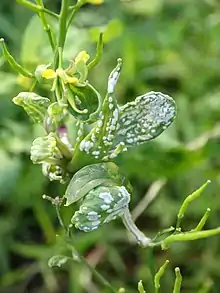Albugo candida
Albugo candida, commonly known as white rust or white blister rust, is an obligate plant pathogen in the family Albuginaceae that infects Brassicaceae species.[2] (Although called a "rust" and a fungus, it is an oomycete.) It has a relatively smaller genome than other oomycetes.[3]
| Albugo candida | |
|---|---|
 | |
| On Shepherd's purse | |
| Scientific classification | |
| Kingdom: | Chromista |
| Phylum: | Oomycota |
| Order: | Albuginales |
| Family: | Albuginaceae |
| Genus: | Albugo |
| Species: | A. candida |
| Binomial name | |
| Albugo candida (Pers.) Kuntze | |
| Synonyms[1] | |
|
Aecidium candidum Pers. (1797) | |

Distribution
Albugo candida has a cosmopolitan distribution and is known from many countries where cruciferous crops are grown in Europe, Asia, Africa, Australasia, North, Central, and South America. It has not been recorded from northern Scandinavia, northern and central Siberia, northern China, western and central Africa, Alaska, northern and central Canada, and southern and western South America.[4]
Hosts
This pathogen infects plants in the family Brassicaceae; the growth stages involved include the seedling stage, the growing stage, the flowering stage, and the fruiting stage.[4] It has been recorded on almost all the varieties and species of the rapeseed-mustard group of crops as well as many wild brassicas. It has also been recorded on plants in the families Aizoaceae, Capparaceae, Cleomaceae, and Amaranthaceae. There are many different races and varieties of A. candida, each infecting its own group of species; for example, one infects Capsella, Arabis, and Lepidium, while another infects Brassica, Diplotaxis, and Sinapis.[5] Certain races of A. candida can colonise the model plant species, Arabidopsis thaliana.[6]
Symptoms
White rust can infect plants both locally and systemically. On stems, leaves, and inflorescences it appears as a mass of white or cream-coloured pustules, each about 2 mm (0.08 in) in diameter, packed with sporangia. New pustules are borne in radial fashion, while older pustules coalesce to form a bigger pustules in the center.[7] The systemic version causes distortion, abnormal growth forms, and sterile inflorescences. The abnormal growth forms are sometimes known as "stagheads".[8] Infection with white rust predisposes a crop to develop downy mildew, caused by another oomycete plant pathogen Phytophthora nicotianae.[9]
Life-cycle
When liberated, the sporangia inside the pustules are spread by wind, rain, and insects. After landing on a susceptible plant, each sporangium gives rise to about six zoospores which, under suitable conditions of moisture and light, form germ tubes which invade the plant's tissues. Zoospores are naked (wall-less), kidney-shaped and bi-flagellate. Both flagella are inserted laterally. Thick-walled sexual spores, called oospores are produced which germinate, producing either vesicles inside the plant tissue, exit tubes with vesicles at the tip, or germ tubes. Further zoospores develop inside the vesicles. The infection is spread by either oospore-infected seed or by mechanical movement of sporangia.[8]
Genome
Several projects have produced draft assemblies of A. candida. The most recent one, using Pacific Biosciences sequencing technology, produced an genome assembly of 38.96 megabases, with 13,073 predicted genes.[10] Amongst 1104 secreted proteins, 110 proteins belong to a class of effectors called "CCGs".
References
- "Albugo candida (Pers.) Roussel: Synonymy". Species Fungorum. Retrieved 24 September 2018.
- Saharan, Govind Singh; Verma, Prithwi Raj; Meena, Prabhu Dayal; Kumar, Arvind (2014). White Rust of Crucifers: Biology, Ecology and Management. Springer. p. 7. ISBN 978-81-322-1792-3.
- Links, Matthew G.; Holub, Eric; Jiang, Rays H.Y.; Sharpe, Andrew G.; Hegedus, Dwayne; Beynon, Elena; Sillito, Dean; Clarke, Wayne E.; Uzuhashi, Shihomi (2011). "De novo sequence assembly of Albugo candida reveals a small genome relative to other biotrophic oomycetes". BMC Genomics. 12: 503. doi:10.1186/1471-2164-12-503. ISSN 1471-2164. PMC 3206522. PMID 21995639.
- "Albugo candida (white rust of crucifers)". Factsheet. CABI. 27 March 2018. Retrieved 10 September 2018.
- Saharan, G.S.; Mehta, Naresh; Sangwan, M.S. (2005). Diseases of Oilseed Crops. Indus Publishing. pp. 40–41. ISBN 978-81-7387-176-4.
- Jouet, Agathe; Saunders, Diane G. O.; McMullan, Mark; Ward, Ben; Furzer, Oliver; Jupe, Florian; Cevik, Volkan; Hein, Ingo; Thilliez, Gaetan J. A.; Holub, Eric; Oosterhout, Cock; Jones, Jonathan D. G. (2019). "Albugo candida race diversity, ploidy and host‐associated microbes revealed using DNA sequence capture on diseased plants in the field". New Phytologist. 221 (3): 1529–1543. doi:10.1111/nph.15417. PMID 30288750. S2CID 52920996.
- O, Akhtar. "Oil yielding plants". Plant diseases identification. Retrieved 2020-06-06.
- Ferreira, Stephen A.; Boley, Rebecca A. (1 November 1991). "Albugo candida". Knowledge Master. Hawaii Department of Agriculture. Retrieved 10 September 2018.
- Saharan, G.S.; Mehta, Naresh; Sangwan, M.S. (2005). Diseases of Oilseed Crops. Indus Publishing. p. 57. ISBN 978-81-7387-176-4.
- Furzer, O. J.; Cevik, V.; Fairhead, S.; Bailey, K.; Redkar, A.; Schudoma, C.; MacLean, D.; Holub, E. B.; Jones JDG (2022). "An Improved Assembly of the Albugo candida Ac2V Genome Reveals the Expansion of the "CCG" Class of Effectors". Molecular Plant-Microbe Interactions. 35 (1): 39–48. doi:10.1094/MPMI-04-21-0075-R. PMID 34546764.
Further reading
- Choi, Young-Joon; Thines, Marco (2011). "Morphological and molecular confirmation of Albugo resedae (Albuginales; Oomycota) as a distinct species from A. candida". Mycological Progress. 10 (2): 143–148. doi:10.1007/s11557-010-0683-4. S2CID 25231366.
- Choi, Young-Joon; Shin, Hyeon-Dong; Ploch, Sebastian; Thines, Marco (July 2011). "Three new phylogenetic lineages are the closest relatives of the widespread species Albugo candida". Fungal Biology. 115 (7): 598–607. doi:10.1016/j.funbio.2011.02.006. PMID 21724165.
- Links, Matthew G.; Holub, Eric; Jiang, Rays H. Y. (13 October 2011). "De novo sequence assembly of Albugo candida reveals a small genome relative to other biotrophic oomycetes". BMC Genomics. 12: 503. doi:10.1186/1471-2164-12-503. PMC 3206522. PMID 21995639.
- Thines, Marco (March 2014). "Phylogeny and evolution of plant pathogenic oomycetes-a global overview". European Journal of Plant Pathology. 138 (3): 431–447. doi:10.1007/s10658-013-0366-5. S2CID 15847435.